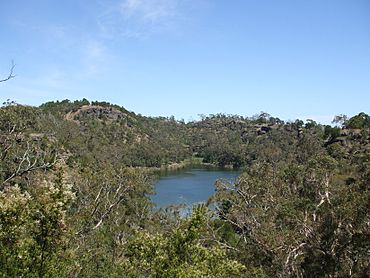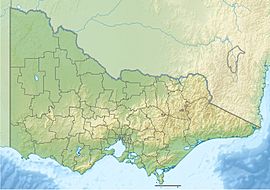Budj Bim National Park facts for kids
Quick facts for kids Budj Bim National ParkVictoria |
|
|---|---|
|
IUCN Category II (National Park)
|
|

Lake Surprise within the national park
|
|
| Nearest town or city | Macarthur |
| Established | 7 June 1960 |
| Area | 54.70 km2 (21.1 sq mi) |
| Managing authorities |
|
| Website | Budj Bim National Park |
| See also | Protected areas of Victoria |
The Budj Bim National Park is a special place in Victoria, Australia. It used to be called Mount Eccles National Park. This park is about 270 kilometers (168 miles) west of Melbourne and 15 kilometers (9 miles) southwest of Macarthur. The park covers an area of 5,470 hectares (13,517 acres).
The park gets its name from Budj Bim, which is a volcano located in the park's northeast. Budj Bim National Park is part of a larger area called the Budj Bim heritage areas. These areas are very important both in Australia and around the world. They are famous for the amazing aquaculture (fish farming) systems built by Aboriginal Australians thousands of years ago. This land is also very special to the Gunditjmara people.
Discover Budj Bim's Volcanic Secrets


Inside Budj Bim National Park, you'll find Budj Bim itself. This place was once called Mount Eccles by European settlers. It is the site of one of Australia's most recently active volcanoes.
The first time Budj Bim became active was about 40,000 years ago. This is when lava flowed out from deep inside the Earth. The most recent eruption happened around 8,000 years ago. Budj Bim looks like a small hill surrounded by green plants. It has a hidden, deep volcanic crater lake called Lake Surprise. The area is also known for its many lava tubes, which are like tunnels formed by flowing lava.
Explore Budj Bim's Rich Heritage
Budj Bim National Park is a very important historical and geological site. In 2004, it was added to the Australian National Heritage List. This was because of its significance to Indigenous history and its unique geology.
On July 6, 2019, Budj Bim became even more famous. It was added to the UNESCO World Heritage List. This means it is recognized as a place of outstanding universal value to humanity. It is one of three parts that make up the Budj Bim Cultural Landscape.
How Budj Bim is Cared For
As of 2020, Budj Bim National Park is managed by several groups working together. These include Parks Victoria and the Gunditj Mirring Traditional Owners Aboriginal Corporation (GMTOAC). Winda-Mara TOAC, another Indigenous organization, also helps.
This joint management is part of an agreement from 2007. It was made between the Gunditjmara people and the Victorian Government. This agreement, called a Native Title Settlement Agreement, ensures that both groups work together to look after the park.
Budj Bim and the 2020 Bushfires
During the 2019-2020 Australian bushfire season, fires did break out in the Budj Bim Cultural Heritage Landscape. Luckily, the ancient stone fish traps and stone house sites were not damaged by the fires. The fires were put out quickly. This was partly because the weather was mild and partly thanks to the hard work of firefighters.
Lake Condah and Condah Mission were also safe from the fires. In the National Park, the campground and picnic area reopened on February 29, 2020. However, some areas like the Lake Surprise walking track and access to Tunnel Cave were closed for a while due to the fire's impact. As of March 19, 2020, the Crater Rim Walk and Lava Canal Walk are open, but their paths were changed a bit near Tunnel Cave.


